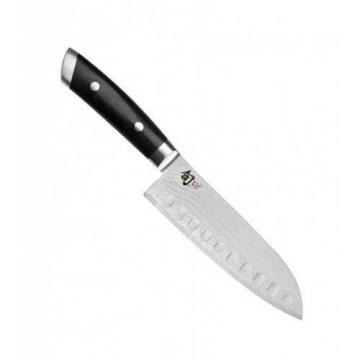
KAI Santoku Knife
Oh, we can tell you a lot about the KAI Santoku Knife. In short: the Santoku Knife is the all-purpose knife of Japanese cuisine. With its almost straight blade, it can perfectly cut meat, fish, and vegetables. Hence the name: Santoku means "knife of three virtues". The wide blade serves as a palette to move the food being cut and provides stability. A KAI Santoku Knife can be found in every series. Additionally, some series also offer a Santoku Knife with a shorter blade, such as the KAI Shun Santoku 14 cm. If you want to learn more, we also have a longer version about KAI Santoku Knives available.
The KAI Santoku
The Santoku knife is the main knife for Japanese chefs. It is used for cutting meat, fish, and vegetables. Thanks to its shape and precise handling, the Santoku has also been popular among European chefs for a long time. It is therefore no surprise that KAI Santoku knives are an important part of every series.
The difference between Santoku and chef's knife
The main knife in European kitchens is the chef's knife, while in Japanese kitchens it is the Santoku. The areas of application are identical. Both knives can handle about 80% of all cutting tasks. However, the knives differ in blade shape. In the classic form, the blade of the chef's knife is curved upwards at the tip. The blade of the Santoku runs straight and has only a slight curve at the tip. The blade of a Santoku is also wider. Nowadays, however, both knives are made with a similar blade shape, so the difference usually only comes down to the wider blade of the Santoku.
One or more Santoku knives in almost every series
A knife collection without a Santoku would not be complete. Therefore, you will find one or more Santoku knives in every series.
The KAI Wasabi Black Santoku has an 18 cm long blade with a hardness of +/- 58 HRC made of a special, corrosion-resistant stainless steel. The oval handle made of a combination of plastic and bamboo powder is extremely robust and waterproof.
The KAI Seki Magoroku Redwood Santoku is equipped with a handle made of Redwood wood. The blade length is 18 cm and is made of Carbon 1K6 stainless steel with a hardness of +/- 58 HRC.
The KAI Shun Classic Santoku comes in blade lengths of 14, 18, and 19 cm. The blades are always made of VG MAX steel, which is covered by 32 layers of corrosion-resistant Damascus steel. This combination gives the knives a stable blade that is both hard and elastic and can score with a hardness of +/- 61 HRC. The chestnut-shaped handle made of dark Pakka wood fits extremely well in the hand. For left-handers, a Santoku with a specially tuned handle is offered.
The KAI Shun Santoku Knife Tim Mälzer Edition with a blade length of 18 cm and a hardness of +/- 61 HRC is already legendary. The blade is a further development of the Shun Classic series: a hammer-finished surface, known in Japan as Tsuchime, is incorporated into the 32 layers of corrosion-resistant Damascus steel that surround the VG-MAX core from the back of the blade to the middle of the blade. An optical highlight with a useful side effect. The notches have a similar effect to kullens and the cutting material adheres less to the blade. The oval handle made of dark, polished walnut wood is a perfect match for the great blade. The appearance, feel, and cutting performance made this Santoku the first-place winner in a KAI Santoku test by Stiftung Warentest. And also the winner of all Santoku knives.
The KAI Seki Magoroku Composite Santoku with its 16.5 cm long blade is always spectacular. Two types of steel are combined in this blade, which are connected in the middle by a special copper soldering. As a special detail, the fine copper line between the satin-finished back of the blade (made of SUS420J2 steel) and the high-gloss polished blade made of VG MAX steel remains visible. This gives the blade a hardness of +/- 61 HRC. The handle made of light Pakka wood gives the Santoku a dynamic appearance, which is also evident when cutting.
KAI without Santoku knives is like Düsseldorf without Altbier. KAI can do Santoku, Düsseldorf can do Altbier. One is not complete without the other. And we can't do without both.










